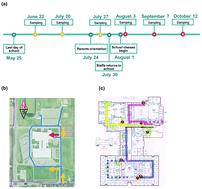当前位置:
X-MOL 学术
›
Environ. Sci.: Water Res. Technol.
›
论文详情
Our official English website, www.x-mol.net, welcomes your
feedback! (Note: you will need to create a separate account there.)
Finding building water quality challenges in a 7 year old green school: implications for building design, sampling, and remediation
Environmental Science: Water Research & Technology ( IF 3.5 ) Pub Date : 2020-08-21 , DOI: 10.1039/d0ew00520g Kyungyeon Ra 1, 2, 3, 4 , Tolulope Odimayomi 2, 3, 4, 5 , Christian Ley 2, 3, 4, 5 , Tiong Gim Aw 4, 6, 7, 8, 9 , Joan B. Rose 4, 10, 11, 12 , Andrew J. Whelton 1, 2, 3, 4, 5
Environmental Science: Water Research & Technology ( IF 3.5 ) Pub Date : 2020-08-21 , DOI: 10.1039/d0ew00520g Kyungyeon Ra 1, 2, 3, 4 , Tolulope Odimayomi 2, 3, 4, 5 , Christian Ley 2, 3, 4, 5 , Tiong Gim Aw 4, 6, 7, 8, 9 , Joan B. Rose 4, 10, 11, 12 , Andrew J. Whelton 1, 2, 3, 4, 5
Affiliation

|
Water safety was investigated at a school certified as a green building. The study was conducted during low water use (summer break) to normal water use (after break) periods. The copper plumbed building contained water saving devices, a water softener and four hot water recirculation zones, and received chloraminated water from a public water system. Six sampling events at 19 in-building locations (and extra 19 locations for metal analysis) were conducted (June 2018 to October 2018). At the building entry point, 65% of the samples (n = 74/114) had no detectable disinfectant residue, heterotrophic plate count ranged from 11 to 400 CFU/100 mL, and no copper action level (AL) exceedances were found; the AL is a health-based threshold. Inside the building, almost 70% of first draw cold samples exceeded the AL during summer, while 37% of samples exceeded the AL after classes resumed. Total copper concentration in the building was related to the distance from the building entry point. The softener was an incubator for bacterial growth and nitrification was detected throughout the plumbing (n = 29/29 for hot, n = 17/22 for cold). The state's recommended spot flushing remediation strategy for reducing copper concentration was ineffective. Water chemical and microbiological testing is recommended before new schools are placed into service and during the life of new and existing buildings. Building water system design standards lack explicit consideration of source water quality, plumbing operation, and material-water compatibility. School plumbing was designed and operated in a way that presented a risk to the health of its occupants.
中文翻译:

在7年历史的绿色学校中发现建筑水质挑战:对建筑设计,采样和修复的影响
一所认证为绿色建筑的学校对水安全进行了调查。该研究是在低用水量(夏季休息)到正常用水量(休息之后)期间进行的。这座铜质的管道大楼内装有节水装置,软水器和四个热水再循环区,并从公共供水系统中接收氯化水。在19个室内地点(以及另外19个金属分析地点)进行了六次采样活动(2018年6月至2018年10月)。在建筑物入口处,样本的65%(n= 74/114)没有可检测到的消毒残留物,异养菌板数范围从11到400 CFU / 100 mL,并且未发现铜作用水平(AL)超出范围;AL是基于健康的阈值。在建筑物内部,夏季将近70%的首次抽风冷样品超过了AL,而在恢复课堂后,有37%的样品超出了AL。建筑物中的总铜浓度与距建筑物入口点的距离有关。软化剂在整个管道中检测到细菌生长和硝化的培养箱(Ñ热= 29/29,Ñ= 17/22(寒冷)。该州建议的减少铜浓度的斑点冲洗补救策略无效。建议在新学校投入使用之前以及新旧建筑物的使用寿命中进行水化学和微生物测试。建筑水系统设计标准没有明确考虑源水水质,管道运行以及材料与水的兼容性。学校水暖管道的设计和操作会对居民的健康造成危险。
更新日期:2020-10-02
中文翻译:

在7年历史的绿色学校中发现建筑水质挑战:对建筑设计,采样和修复的影响
一所认证为绿色建筑的学校对水安全进行了调查。该研究是在低用水量(夏季休息)到正常用水量(休息之后)期间进行的。这座铜质的管道大楼内装有节水装置,软水器和四个热水再循环区,并从公共供水系统中接收氯化水。在19个室内地点(以及另外19个金属分析地点)进行了六次采样活动(2018年6月至2018年10月)。在建筑物入口处,样本的65%(n= 74/114)没有可检测到的消毒残留物,异养菌板数范围从11到400 CFU / 100 mL,并且未发现铜作用水平(AL)超出范围;AL是基于健康的阈值。在建筑物内部,夏季将近70%的首次抽风冷样品超过了AL,而在恢复课堂后,有37%的样品超出了AL。建筑物中的总铜浓度与距建筑物入口点的距离有关。软化剂在整个管道中检测到细菌生长和硝化的培养箱(Ñ热= 29/29,Ñ= 17/22(寒冷)。该州建议的减少铜浓度的斑点冲洗补救策略无效。建议在新学校投入使用之前以及新旧建筑物的使用寿命中进行水化学和微生物测试。建筑水系统设计标准没有明确考虑源水水质,管道运行以及材料与水的兼容性。学校水暖管道的设计和操作会对居民的健康造成危险。











































 京公网安备 11010802027423号
京公网安备 11010802027423号